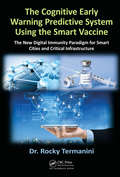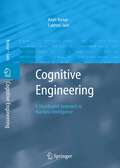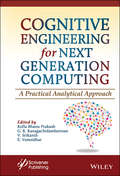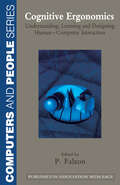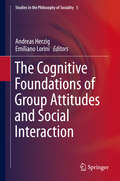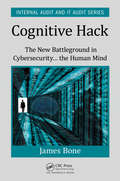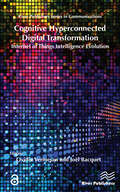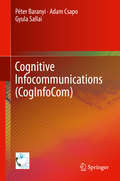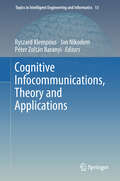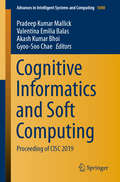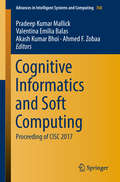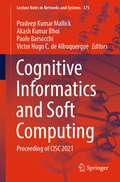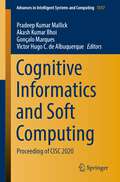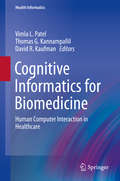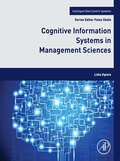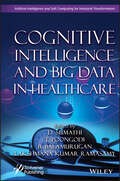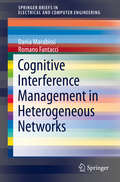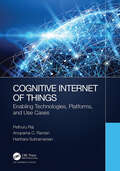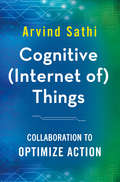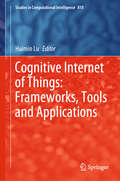- Table View
- List View
The Cognitive Early Warning Predictive System Using the Smart Vaccine: The New Digital Immunity Paradigm for Smart Cities and Critical Infrastructure
by Rocky TermaniniThis book introduces the Cognitive Early Warning Predictive System (CEWPS ) as the new digital immune system. Similar to the human immune system, CEWPS relies on true or "inoculated" sickness experience to defend the body. The book also introduces The Smart Vaccine an intelligent agent that manages all the vaccination-as-a-service on the cloud before an attack happens. The book illustrates the current landscape of cyber warfare, highlights the vulnerabilities of critical infrastructure, and identifies the shortcomings of AVT. Next, it describes the concept, the architecture, and the enabling technologies required to build a digital immune system.
Cognitive Engineering: A Distributed Approach to Machine Intelligence (Advanced Information and Knowledge Processing)
by Amit KonarWhat we profoundly witness these days is a growing number of human-centric systems and a genuine interest in a comprehensive understanding of their underlying paradigms and the development of solid and efficient design practices. We are indeed in the midst of the next information revolution, which very likely brings us into a completely new world of ubiquitous and invisible computing, Ambient Intelligent (AMI), and wearable hardware. This requires a totally new way of thinking in which cognitive aspects of design, cognitive system engineering and distributed approach play a pivotal role. This book fully addresses these timely needs by filling a gap between the two well-established disciplines of cognitive sciences and cognitive systems engineering. As we put succinctly in the preface, with the psychological perspective of human cognition in mind, “the book explores the computational models of reasoning, learning, planning and multi-agent coordination and control of the human moods”. This is an excellent, up to the point description of the book. The treatise is focused on the underlying fundamentals, spans across a vast territory embracing logic perspectives of human cognition, distributed models, parallel computing, expert systems, and intelligent robotics.
Cognitive Engineering for Next Generation Computing: A Practical Analytical Approach
by Kolla Bhanu Prakash G. R. Kanagachidambaresan V. Srikanth E. VamsidharThe cognitive approach to the IoT provides connectivity to everyone and everything since IoT connected devices are known to increase rapidly. When the IoT is integrated with cognitive technology, performance is improved, and smart intelligence is obtained. Discussed in this book are different types of datasets with structured content based on cognitive systems. The IoT gathers the information from the real time datasets through the internet, where the IoT network connects with multiple devices. This book mainly concentrates on providing the best solutions to existing real-time issues in the cognitive domain. Healthcare-based, cloud-based and smart transportation-based applications in the cognitive domain are addressed. The data integrity and security aspects of the cognitive computing main are also thoroughly discussed along with validated results.
Cognitive Engineering for Next Generation Computing: A Practical Analytical Approach
by Kolla Bhanu Prakash V. Srikanth E. Vamsidhar G. R. KanagachidambaresanThe cognitive approach to the IoT provides connectivity to everyone and everything since IoT connected devices are known to increase rapidly. When the IoT is integrated with cognitive technology, performance is improved, and smart intelligence is obtained. Discussed in this book are different types of datasets with structured content based on cognitive systems. The IoT gathers the information from the real time datasets through the internet, where the IoT network connects with multiple devices. This book mainly concentrates on providing the best solutions to existing real-time issues in the cognitive domain. Healthcare-based, cloud-based and smart transportation-based applications in the cognitive domain are addressed. The data integrity and security aspects of the cognitive computing main are also thoroughly discussed along with validated results.
Cognitive Ergonomics: Understanding, Learning, and Designing Human-Computer Interaction (Computers and People)
by Brian R. Gaines Andrew F. MonkThis reference work covers the breadth of cognitive ergonomics in human*b1computer interaction (HCI). Covering models for design, learning procedures, and planning and understanding, this book is specifically concerned with the cognitive ergonomics of human*b1computer interaction--from analogical thinking to spreadsheet calculation, office organization to process control. It provides an overview of HCI issues from the cognitive perspective.
The Cognitive Foundations of Group Attitudes and Social Interaction (Studies in the Philosophy of Sociality #5)
by Andreas Herzig Emiliano LoriniThis book offers a widely interdisciplinary approach to investigating important questions surrounding the cognitive foundations of group attitudes and social interaction. The volume tackles issues such as the relationship between individual and group attitudes, the cognitive bases of group identity and group identification and the link between emotions and individual attitudes.This volume delves into the links between individual attitudes (such as beliefs, goals and intentions) and how they are reflected in shared attitudes where common belief, collective acceptance, joint intentions, and group preferences come into play. It pursues answers to the connections between trust and beliefs, goals and intentions and attempts to investigate questions such as: does trust have an affective component and how it may relate to hope and fear? The volume also scrutinizes game theory and questions whether it can satisfactorily explain and model social interaction and if there may be any concepts which are not addressed by the current theory. Contributors are derived from disciplines including philosophy, economics, psychology, logic and computer science. Interdisciplinary in scope and comprehensive detail, this volume integrates a variety of approaches – philosophical, psychological and artificial intelligence – to strategic, normative and emotional aspects of social interaction.
Cognitive Hack: The New Battleground in Cybersecurity ... the Human Mind (Internal Audit and IT Audit)
by James BoneThis book explores a broad cross section of research and actual case studies to draw out new insights that may be used to build a benchmark for IT security professionals. This research takes a deeper dive beneath the surface of the analysis to uncover novel ways to mitigate data security vulnerabilities, connect the dots and identify patterns in the data on breaches. This analysis will assist security professionals not only in benchmarking their risk management programs but also in identifying forward looking security measures to narrow the path of future vulnerabilities.
Cognitive Hack: The New Battleground in Cybersecurity ... the Human Mind (Security, Audit and Leadership Series)
by James BoneThis book explores a broad cross section of research and actual case studies to draw out new insights that may be used to build a benchmark for IT security professionals. This research takes a deeper dive beneath the surface of the analysis to uncover novel ways to mitigate data security vulnerabilities, connect the dots and identify patterns in the data on breaches. This analysis will assist security professionals not only in benchmarking their risk management programs but also in identifying forward looking security measures to narrow the path of future vulnerabilities.
Cognitive Hyperconnected Digital Transformation: Internet of Things Intelligence Evolution
by Ovidiu Vermesan Joël BacquetCognitive Hyperconnected Digital Transformation provides an overview of the current Internet of Things (IoT) landscape, ranging from research, innovation and development priorities to enabling technologies in a global context. It is intended as a standalone book in a series that covers the Internet of Things activities of the IERC-Internet of Things European Research Cluster, including both research and technological innovation, validation and deployment. The book builds on the ideas put forward by the European Research Cluster, the IoT European Platform Initiative (IoT-EPI) and the IoT European Large-Scale Pilots Programme, presenting global views and state-of-the-art results regarding the challenges facing IoT research, innovation, development and deployment in the next years. Hyperconnected environments integrating industrial/business/consumer IoT technologies and applications require new IoT open systems architectures integrated with network architecture (a knowledge-centric network for IoT), IoT system design and open, horizontal and interoperable platforms managing things that are digital, automated and connected and that function in real-time with remote access and control based on Internet-enabled tools. The IoT is bridging the physical world with the virtual world by combining augmented reality (AR), virtual reality (VR), machine learning and artificial intelligence (AI) to support the physical-digital integrations in the Internet of mobile things based on sensors/actuators, communication, analytics technologies, cyber-physical systems, software, cognitive systems and IoT platforms with multiple functionalities. These IoT systems have the potential to understand, learn, predict, adapt and operate autonomously. They can change future behaviour, while the combination of extensive parallel processing power, advanced algorithms and data sets feed the cognitive algorithms that allow the IoT systems to develop new services and propose new solutions. IoT technologies are moving into the industrial space and enhancing traditional industrial platforms with solutions that break free of device-, operating system- and protocol-dependency. Secure edge computing solutions replace local networks, web services replace software, and devices with networked programmable logic controllers (NPLCs) based on Internet protocols replace devices that use proprietary protocols. Information captured by edge devices on the factory floor is secure and accessible from any location in real time, opening the communication gateway both vertically (connecting machines across the factory and enabling the instant availability of data to stakeholders within operational silos) and horizontally (with one framework for the entire supply chain, across departments, business units, global factory locations and other markets). End-to-end security and privacy solutions in IoT space require agile, context-aware and scalable components with mechanisms that are both fluid and adaptive. The convergence of IT (information technology) and OT (operational technology) makes security and privacy by default a new important element where security is addressed at the architecture level, across applications and domains, using multi-layered distributed security measures. Blockchain is transforming industry operating models by adding trust to untrusted environments, providing distributed security mechanisms and transparent access to the information in the chain. Digital technology platforms are evolving, with IoT platforms integrating complex information systems, customer experience, analytics and intelligence to enable new capabilities and business models for digital business.
Cognitive Hyperconnected Digital Transformation: Internet of Things Intelligence Evolution
Cognitive Hyperconnected Digital Transformation provides an overview of the current Internet of Things (IoT) landscape, ranging from research, innovation and development priorities to enabling technologies in a global context. It is intended as a standalone book in a series that covers the Internet of Things activities of the IERC-Internet of Things European Research Cluster, including both research and technological innovation, validation and deployment. The book builds on the ideas put forward by the European Research Cluster, the IoT European Platform Initiative (IoT-EPI) and the IoT European Large-Scale Pilots Programme, presenting global views and state-of-the-art results regarding the challenges facing IoT research, innovation, development and deployment in the next years. Hyperconnected environments integrating industrial/business/consumer IoT technologies and applications require new IoT open systems architectures integrated with network architecture (a knowledge-centric network for IoT), IoT system design and open, horizontal and interoperable platforms managing things that are digital, automated and connected and that function in real-time with remote access and control based on Internet-enabled tools. The IoT is bridging the physical world with the virtual world by combining augmented reality (AR), virtual reality (VR), machine learning and artificial intelligence (AI) to support the physical-digital integrations in the Internet of mobile things based on sensors/actuators, communication, analytics technologies, cyber-physical systems, software, cognitive systems and IoT platforms with multiple functionalities. These IoT systems have the potential to understand, learn, predict, adapt and operate autonomously. They can change future behaviour, while the combination of extensive parallel processing power, advanced algorithms and data sets feed the cognitive algorithms that allow the IoT systems to develop new services and propose new solutions. IoT technologies are moving into the industrial space and enhancing traditional industrial platforms with solutions that break free of device-, operating system- and protocol-dependency. Secure edge computing solutions replace local networks, web services replace software, and devices with networked programmable logic controllers (NPLCs) based on Internet protocols replace devices that use proprietary protocols. Information captured by edge devices on the factory floor is secure and accessible from any location in real time, opening the communication gateway both vertically (connecting machines across the factory and enabling the instant availability of data to stakeholders within operational silos) and horizontally (with one framework for the entire supply chain, across departments, business units, global factory locations and other markets). End-to-end security and privacy solutions in IoT space require agile, context-aware and scalable components with mechanisms that are both fluid and adaptive. The convergence of IT (information technology) and OT (operational technology) makes security and privacy by default a new important element where security is addressed at the architecture level, across applications and domains, using multi-layered distributed security measures. Blockchain is transforming industry operating models by adding trust to untrusted environments, providing distributed security mechanisms and transparent access to the information in the chain. Digital technology platforms are evolving, with IoT platforms integrating complex information systems, customer experience, analytics and intelligence to enable new capabilities and business models for digital business.
Cognitive Infocommunications (CogInfoCom)
by Péter Baranyi Adam Csapo Gyula SallaiThis book describes the theoretical foundations of cognitive infocommunications (CogInfoCom), and provides a survey on state-of-the-art solutions and applications within the field. The book covers aspects of cognitive infocommunications in research fields such as affective computing, BCI, future internet, HCI, HRI, sensory substitution, and virtual/augmented interactions, and also introduces newly proposed paradigms and initiatives under the field, including CogInfoCom channels, speechability and socio-cognitive ICT. The book focuses on describing the merging between humans and information and communications technology (ICT) at the level of cognitive capabilities with an approach towards developing future cognitive ICT.
Cognitive Infocommunications, Theory and Applications (Topics in Intelligent Engineering and Informatics #13)
by Ryszard Klempous Jan Nikodem Péter Zoltán BaranyiThe book gathers the chapters of Cognitive InfoCommunication research relevant to a variety of application areas, including data visualization, emotion expression, brain-computer interfaces or speech technologies. It provides an overview of the kind of cognitive capabilities that are being analyzed and developed. Based on this common ground, it may become possible to see new opportunities for synergy among disciplines that were heretofore viewed as being separate.Cognitive InfoCommunication begins by modeling human cognitive states and aptitudes in order to better understand what the user of a system is capable of comprehending and doing. The patterns of exploration and the specific tools that are described can certainly be of interest and of great relevance for all researchers who focus on modeling human states and aptitudes.This innovative research area provides answers to the latest challenges in influence of cognitive states and aptitudes in order to facilitate learning or generally improve performance in certain cognitive tasks such as decision making. Some capabilities are purely human, while others are purely artificial, but in general this distinction is rarely clear-cut. Therefore, when discussing new human cognitive capabilities, the technological background which makes them possible cannot be neglected, and indeed often plays a central role.This book highlights the synergy between various fields that are perfectly fit under the umbrella of CogInfoCom and contribute to understanding and developing new, human-artificial intelligence hybrid capabilities. These, merged capabilities are currently appearing, and the importance of the role they play in everyday life are unique to the cognitive entity generation that is currently growing up.
Cognitive Informatics and Soft Computing: Proceeding of CISC 2019 (Advances in Intelligent Systems and Computing #1040)
by Pradeep Kumar Mallick Valentina Emilia Balas Akash Kumar Bhoi Gyoo-Soo ChaeThe book presents new approaches and methods for solving real-world problems. It highlights, in particular, innovative research in the fields of Cognitive Informatics, Cognitive Computing, Computational Intelligence, Advanced Computing, and Hybrid Intelligent Models and Applications. New algorithms and methods in a variety of fields are presented, together with solution-based approaches. The topics addressed include various theoretical aspects and applications of Computer Science, Artificial Intelligence, Cybernetics, Automation Control Theory, and Software Engineering.
Cognitive Informatics and Soft Computing: Proceeding of CISC 2017 (Advances in Intelligent Systems and Computing #768)
by Pradeep Kumar Mallick Valentina Emilia Balas Akash Kumar Bhoi Ahmed F. ZobaaThe book presents new approaches and methods for solving real-world problems. It offers, in particular, exploratory research that describes novel approaches in the fields of Cognitive Informatics, Cognitive Computing, Computational Intelligence, Advanced Computing, Hybrid Intelligent Models and Applications. New algorithms and methods in a variety of fields are also presented, together with solution-based approaches. The topics addressed include various theoretical aspects and applications of Computer Science, Artificial Intelligence, Cybernetics, Automation Control Theory and Software Engineering.
Cognitive Informatics and Soft Computing: Proceeding of CISC 2021 (Lecture Notes in Networks and Systems #375)
by Pradeep Kumar Mallick Akash Kumar Bhoi Paolo Barsocchi Victor Hugo C. de AlbuquerqueThis book presents best selected research papers presented at the 4th International Conference on Cognitive Informatics and Soft Computing (CISC 2021), held at Balasore College of Engineering & Technology, Balasore, Odisha, India, from 21–22 August 2021. It highlights, in particular, innovative research in the fields of cognitive informatics, cognitive computing, computational intelligence, advanced computing, and hybrid intelligent models and applications. New algorithms and methods in a variety of fields are presented, together with solution-based approaches. The topics addressed include various theoretical aspects and applications of computer science, artificial intelligence, cybernetics, automation control theory, and software engineering.
Cognitive Informatics and Soft Computing: Proceeding of CISC 2020 (Advances in Intelligent Systems and Computing #1317)
by Pradeep Kumar Mallick Akash Kumar Bhoi Gonçalo Marques Victor Hugo C. de AlbuquerqueThis book presents best selected research papers presented at the 3rd International Conference on Cognitive Informatics and Soft Computing (CISC 2020), held at Balasore College of Engineering & Technology, Balasore, Odisha, India, from 12 to 13 December 2020. It highlights, in particular, innovative research in the fields of cognitive informatics, cognitive computing, computational intelligence, advanced computing, and hybrid intelligent models and applications. New algorithms and methods in a variety of fields are presented, together with solution-based approaches. The topics addressed include various theoretical aspects and applications of computer science, artificial intelligence, cybernetics, automation control theory, and software engineering.
Cognitive Informatics for Biomedicine: Human Computer Interaction in Healthcare (Health Informatics)
by Vimla L. Patel Thomas G. Kannampallil David R. KaufmanThe book reports on the current state on HCI in biomedicine and health care, focusing on the role of human factors, patient safety well as methodological underpinnings of HCI theories and its application for biomedical informatics. Theories, models and frameworks for human-computer interaction (HCI) have been recognized as key contributors for the design, development and use of computer-based systems. In the clinical domain, key themes that litter the research landscape of health information technology (HIT) are usability, decision support and clinical workflow – all of which are affected directly or indirectly by the nature of HCI. While the implications of HCI principles for the design of HIT are acknowledged, the adoption of the tools and techniques among clinicians, informatics researchers and developers of HIT are limited. There is a general consensus that HIT has not realized its potential as a tool to facilitate clinical decision-making, the coordination of care and improves patient safety. Embracing sound principles of iterative design can yield significant dividends. It can also enhance practitioner’s abilities to meet “meaningful use” requirements. The purpose of the book is two-fold: to address key gaps on the applicability of theories, models and evaluation frameworks of HCI and human factors for research in biomedical informatics. It highlights the state of the art, drawing from the current research in HCI. Second, it also serves as a graduate level textbook highlighting key topics in HCI relevant for biomedical informatics, computer science and social science students working in the healthcare domain. For instructional purposes, the book provides additional information and a set of questions for interactive class discussion for each section. The purpose of these questions is to encourage students to apply the learned concepts to real world healthcare problems.
Cognitive Information Systems in Management Sciences (Intelligent Data-Centric Systems: Sensor Collected Intelligence)
by Lidia Dominika OgielaCognitive Information Systems in Management Sciences summarizes the body of work in this area, taking an analytical approach to interpreting the data, while also providing an approach that can be used for practical implementation in the fields of computing, economics, and engineering. Using numerous illustrative examples, and following both theoretical and practical results, Dr. Lidia Ogiela discusses the concepts and principles of cognitive information systems, the relationship between intelligent computer data analysis, and how to utilize computational intelligent approaches to enhance information retrieval. Real world implantation use cases round out the book, with valuable scenarios covering management science, computer science, and engineering. Indexing: The books of this series are submitted to EI-Compendex and SCOPUSDiscusses the basic concepts and principles in cognitive information systems, providing ‘real-world' implementation examplesExplains the relationship between intelligent computer data analysis and how to utilize computational intelligent approaches to enhance information retrievalProvides a unified structured approach that can be used to develop information flow in cognitive management systems
Cognitive Intelligence and Big Data in Healthcare (Artificial Intelligence and Soft Computing for Industrial Transformation)
by D. Sumathi T. Poongodi B. Balamurugan Lakshmana Kumar RamasamyCOGNITIVE INTELLIGENCE AND BIG DATA IN HEALTHCARE Applications of cognitive intelligence, advanced communication, and computational methods can drive healthcare research and enhance existing traditional methods in disease detection and management and prevention. As health is the foremost factor affecting the quality of human life, it is necessary to understand how the human body is functioning by processing health data obtained from various sources more quickly. Since an enormous amount of data is generated during data processing, a cognitive computing system could be applied to respond to queries, thereby assisting in customizing intelligent recommendations. This decision-making process could be improved by the deployment of cognitive computing techniques in healthcare, allowing for cutting-edge techniques to be integrated into healthcare to provide intelligent services in various healthcare applications. This book tackles all these issues and provides insight into these diversified topics in the healthcare sector and shows the range of recent innovative research, in addition to shedding light on future directions in this area. Audience The book will be very useful to a wide range of specialists including researchers, engineers, and postgraduate students in artificial intelligence, bioinformatics, information technology, as well as those in biomedicine.
Cognitive Intelligence and Big Data in Healthcare (Artificial Intelligence and Soft Computing for Industrial Transformation)
by D. Sumathi T. Poongodi S. Balamurugan R. Lakshmana KumarCOGNITIVE INTELLIGENCE AND BIG DATA IN HEALTHCARE Applications of cognitive intelligence, advanced communication, and computational methods can drive healthcare research and enhance existing traditional methods in disease detection and management and prevention. As health is the foremost factor affecting the quality of human life, it is necessary to understand how the human body is functioning by processing health data obtained from various sources more quickly. Since an enormous amount of data is generated during data processing, a cognitive computing system could be applied to respond to queries, thereby assisting in customizing intelligent recommendations. This decision-making process could be improved by the deployment of cognitive computing techniques in healthcare, allowing for cutting-edge techniques to be integrated into healthcare to provide intelligent services in various healthcare applications. This book tackles all these issues and provides insight into these diversified topics in the healthcare sector and shows the range of recent innovative research, in addition to shedding light on future directions in this area. Audience The book will be very useful to a wide range of specialists including researchers, engineers, and postgraduate students in artificial intelligence, bioinformatics, information technology, as well as those in biomedicine.
Cognitive Interference Management in Heterogeneous Networks (SpringerBriefs in Electrical and Computer Engineering)
by Dania Marabissi Romano FantacciThis brief investigates the role of interference management in Heterogeneous Networks (Het Nets), focusing on cognitive approaches and the use of beamforming. Key concepts of Het Nets are introduced and different deployment strategies are examined, such as sharing the same frequency band of the macro cells or using new high frequency bands. Particular attention is devoted to co-channel deployment and to the problem of interference management, addressing various strategies that can be adopted to handle the interference between the cells. In addition, the brief explores cognitive small cells which are able to avoid or limit interference by using suitable beamforming and resource allocation schemes. The suggested solutions are supported by numerical results in terms of performance evaluations and comparisons.
Cognitive Internet of Things: Enabling Technologies, Platforms, and Use Cases
by Pethuru Raj Anupama C. Raman Harihara SubramanianThe Internet of Things (IoT) concept is defined as a flexible and futuristic network where all the different types of devices and smart objects can become seamlessly connected to each other and can actively participate in all types of processes which are happening around us. The grand objective of making physical, mechanical, electrical, and electronic devices to use the deeper and extreme connectivity and service-enablement techniques is to make them intelligent in their deeds, decisions, and deals. Cognitive IoT is the application of cognitive computing technologies to the data which is generated by the connected devices of the IoT ecosystem. Cognition means thinking; however, computers are not yet fully capable of mimicking human like thought. However, the present-day computer systems can perform some functions which are like the capability of human beings to think. Cognitive Internet of Things: Enabling Technologies, Platforms, and Use Cases explains the concepts surrounding Cognitive IoT. It also looks at the use cases and such supporting technologies as artificial intelligence and machine learning that act as key enablers of Cognitive IoT ecosystem. Different Cognitive IoT enabled platforms like IBM Watson and other product specific use cases like Amazon Alexa are covered in depth. Other highlights of the book include: Demystifying the cognitive computing paradigm Delineating the key capabilities of cognitive cloud environments Deep learning algorithms for cognitive IoT solutions Natural language processing (NLP) methods for cognitive IoT systems Designing a secure infrastructure for cognitive IoT platforms and applications
Cognitive Internet of Things: Enabling Technologies, Platforms, and Use Cases
by Pethuru Raj Anupama C. Raman Harihara SubramanianThe Internet of Things (IoT) concept is defined as a flexible and futuristic network where all the different types of devices and smart objects can become seamlessly connected to each other and can actively participate in all types of processes which are happening around us. The grand objective of making physical, mechanical, electrical, and electronic devices to use the deeper and extreme connectivity and service-enablement techniques is to make them intelligent in their deeds, decisions, and deals. Cognitive IoT is the application of cognitive computing technologies to the data which is generated by the connected devices of the IoT ecosystem. Cognition means thinking; however, computers are not yet fully capable of mimicking human like thought. However, the present-day computer systems can perform some functions which are like the capability of human beings to think. Cognitive Internet of Things: Enabling Technologies, Platforms, and Use Cases explains the concepts surrounding Cognitive IoT. It also looks at the use cases and such supporting technologies as artificial intelligence and machine learning that act as key enablers of Cognitive IoT ecosystem. Different Cognitive IoT enabled platforms like IBM Watson and other product specific use cases like Amazon Alexa are covered in depth. Other highlights of the book include: Demystifying the cognitive computing paradigm Delineating the key capabilities of cognitive cloud environments Deep learning algorithms for cognitive IoT solutions Natural language processing (NLP) methods for cognitive IoT systems Designing a secure infrastructure for cognitive IoT platforms and applications
Cognitive (Internet of) Things: Collaboration to Optimize Action
by Arvind SathiThis book explores cognitive behavior among Internet of Things. Using a series of current and futuristic examples – appliances, personal assistants, robots, driverless cars, customer care, engineering, monetization, and many more – the book covers use cases, technology and communication aspects of how machines will support individuals and organizations. This book examines the Cognitive Things covering a number of important questions: • What are Cognitive Things? • What applications can be driven from Cognitive Things – today and tomorrow? • How will these Cognitive Things collaborate with each and other, with individuals and with organizations? • What is the cognitive era? How is it different from the automation era? • How will the Cognitive Things support or accelerate human problem solving? • Which technical components make up cognitive behavior? • How does it redistribute the work-load between humans and machines? • What types of data can be collected from them and shared with external organizations? • How do they recognize and authenticate authorized users? How is the data safeguarded from potential theft? Who owns the data and how are the data ownership rights enforced? Overall, Sathi explores ways in which Cognitive Things bring value to individuals as well as organizations and how to integrate the use of the devices into changing organizational structures. Case studies are used throughout to illustrate how innovators are already benefiting from the initial explosion of devices and data. Business executives, operational managers, and IT professionals will understand the fundamental changes required to fully benefit from cognitive technologies and how to utilize them for their own success.
Cognitive Internet of Things: Frameworks, Tools and Applications (Studies in Computational Intelligence #810)
by Huimin LuThis book provides insights into the research in the fields of artificial intelligence in combination with Internet of Things (IoT) technologies. Today, the integration of artificial intelligence and IoT technologies is attracting considerable interest from both researchers and developers from academic fields and industries around the globe. It is foreseeable that the next generation of IoT research will focus on artificial intelligence/beyond artificial intelligence approaches. The rapidly growing numbers of artificial intelligence algorithms and big data solutions have significantly increased the number of potential applications for IoT technologies, but they have also created new challenges for the artificial intelligence community. This book shares the latest scientific advances in this area.
